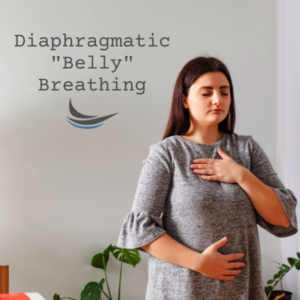 A basic yet effective self-soothing technique for anxiety and trauma-related responses is diaphragmatic-breathing. This technique is otherwise known as “belly breathing” due to engaging the diaphragm (a large muscle which is at the base of the lungs).
A basic yet effective self-soothing technique for anxiety and trauma-related responses is diaphragmatic-breathing. This technique is otherwise known as “belly breathing” due to engaging the diaphragm (a large muscle which is at the base of the lungs).
Breathing is something that comes naturally; however, our everyday breathing typically involves taking shallow breaths. By being intentional with practicing diaphragmatic breathing you will notice your stomach rise and fall as the diaphragm contracts and relaxes the air that is filled and released from the lungs. If you would like to feel more relaxed in your day-to-day life, then keep reading!
Diaphragmatic-breathing benefits can help soothe the physiological effects-of-anxiety-on-the-body.
Deep breathing from the belly can help–
- Lower your heart rate
- Relax your muscles/ reduce tension
- Slow down your breathing
- Reduce blood pressure
- Soothe trauma-related responses
- Reduce stress/ lower cortisol
- Increase efficiency of the lungs
- Strengthen the diaphragm
- Improve stability with core muscles
Diaphragmatic breathing can be practiced either lying down or in a seated position. Beginners may find that lying down is easier to practice. It is important to comfortable with your knees bent and head supported.
One hand is placed on the middle of your upper chest, while the other is placed just below the rib cage.
Take a deep breath in slowly through your nose to draw the breath down towards your stomach. You should begin to feel your stomach move out against your hand. Keep the hand on your chest as still as possible.
Take a deep breath out while tightening your stomach muscles and allowing the stomach to fall downward. Again, keep the hand on your chest as still as possible.
Focus on your breathing and repeat for at least 5-10 minutes which can be practiced 3-4 times a day.
There are variations in abdominal-breathing activities such as Alternate-Nostril Breathing, Belly Breathing, Box Breathing, 4-7-8 Breathing, and Lion’s Breath.
Children (and adults!) can be taught abdominal breathing in creative ways, as there are tailored interventions that can make breathing fun. If you are interested in learning more about this technique and would like to practice with a therapist, CARE clinicians are available to help.
Written By: Charlotte Johnson, MA, LPCC
We’re Here to help
Our wellness experts will be happy to take care of you. You can CLICK HERE to schedule an appointment now or call (612)223-8898.
Meet Clinicians
We’re united by our commitment to providing effective, relevant, and innovative mental health support at all stages of your journey. Click Here to find out more about who we are, where we come from, and how we live out CARE’s mission every day.
The professionals at CARE are actively collecting and creating resources to help with what you need. We’re Here for You.



